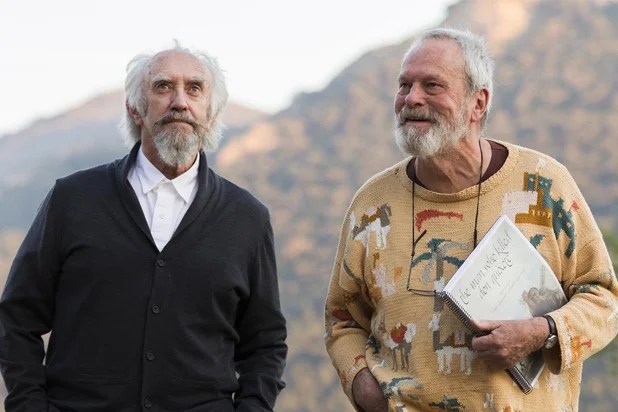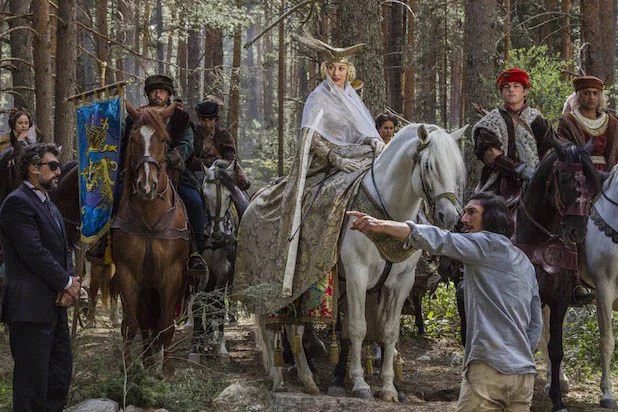Terry Gilliam has tried to make his film “The Man Who Killed Don Quixote” for over two decades and barring some final unforeseen tragedy, his film will open in theaters on April 10 for one night only as part of a release with Screen Media and Fathom Events.
It’s the classic production from hell, complete with on-set injuries, lost funding, natural disasters and outsized ambitions worthy of the hero of Miguel de Cervantes’ classic novel. Even after it wrapped, a lawsuit threatened to derail the film from screening at Cannes, and Amazon Studios pulled out of a deal to distribute the film in the U.S.
So the irony isn’t lost on anyone that Gilliam’s quest to make a movie about Don Quixote has been nothing if not quixotic. Here’s a not-so-brief timeline of every step on the road to Gilliam getting his film made.
1997
Gilliam started thinking about an adaptation of Cervantes’ 1615 novel “Don Quixote” in the early ’90s, and in a 1997 interview with Neon Magazine, he revealed “Don Quixote” as one of the “10 movies they wouldn’t let me make.”
“The years I wasted on this one,” he lamented, hardly realizing how quaint that now sounds. He originally asked for $20 million in funding from Europe and found that still wasn’t enough for his vision.
Gilliam also revealed that the studio wanted Sean Connery for the title role, but the actor left the project to make “The Defective Detective” (another movie that never came to pass). The director was replaced by Fred Schepesi, with John Cleese and Robin Williams in the lead roles, though that version never panned out either. “That really hurts, that I let a project I’m convinced I’m the best director on the planet to do, slip by,” Gilliam said.
1998
After the U.K. premiere of “Fear and Loathing in Las Vegas” in 1998, Gilliam said that “The Man Who Killed Don Quixote” would be his next film. He had secured a $32 million budget and planned to begin production in Spain in September 2000.
In this version, Quixote would be played by French actor Jean Rochefort, who had learned English for the role, with the director’s “Fear and Loathing” star Johnny Depp as the Sancho Panza figure.
The script he wrote with Tony Grisoni was about a 21st-century ad executive (Depp) who travels back in time to the 17th century and gets mistaken for Sancho Panza. The story also drew inspiration from Mark Twain’s “A Connecticut Yankee in King Arthur’s Court,” another of the 10 movies Gilliam said he hoped to adapt for the screen in that Neon interview.

September 2000
The production appeared cursed from day one. As documented in the 2002 documentary “Lost in La Mancha,” production began north of Madrid near a Spanish military base and fighter planes flying overhead drowned out the sound recording.
On the second day of shooting, a flood washed through the area, causing the crew to lose equipment and for the landscape to be changed so drastically that it affected continuity. And after feeling pain from riding a horse, Rochefort was then sent to a doctor in Paris and was found to have a back issue.
He would not return, and production was canceled altogether in November. Nicola Pecorini, the film’s director of photography, said in the documentary, “Never in 22 years of being in this business have I seen such a sum of bad luck.”
September 2005
Gilliam’s interest in “Don Quixote” perked up again in 2005, when “Tideland” producer Jeremy Thomas came on board the project and Gilliam hinted that he wanted Gerard Depardieu to play the lead role.
June 2009
Johnny Depp breathed new life into the project when he told Ain’t It Cool News that he loved Gilliam and was still on board — though he hedged about whether he would be available given his commitment to the “Pirates of the Caribbean” movies.
“I’d hate to put him in a position — or ask to be in a position — where he’d have to wait for me. That would be wrong,” Depp said. “But also… I feel like we went there and tried something, and, whatever it was — the elements and all the things that got up underneath us – -were there and happened and were documented well in that film ‘Lost in La Mancha.’ So I don’t know if it’s right for me to go back there. I don’t know if it’s right for Terry to, but if he wants to…”

December 2009
Collider reported that Gilliam wanted Robert Duvall for the lead role of Don Quixote, but only “if they get the money,” Duvall said.
May 2010
With Depp tied up, Gilliam turned to Ewan McGregor to play the Sancho Panza role opposite Duvall. He also said that he slashed the budget to a mere $20 million.
September 2010
Funding falls apart again for Gilliam’s film, despite having Robert Duvall and Ewan McGregor attached. “I shouldn’t be here. The plan was to be shooting ‘Quixote’ right now,” Gilliam told Variety.
November 2013
Shortly after releasing his sci-fi “The Zero Theorem,” Gilliam confirmed to ComingSoon.net that he had begun preproduction on a seventh version of on “The Man Who Killed Don Quixote.”
“Lucky seven, maybe,” he said. “We’ll see if it happens. This is kind of my default position, going back to that. I actually just want to make it and get rid of it. Get it out of my life.”
August 2014
Gilliam told TheWrap that he secured funding for “Don Quixote” and planned to shoot it in early 2015 — with the film now set in the present day and revolving around a movie being made about Quixote. “I keep incorporating my own life into it and shifting it,” Gilliam said. “I’ve done it so many times — or not done it so many times — I’ll believe it when I see it.”

September-November 2014
After another casting “hiccup” that Gilliam described to Rolling Stone as a “Sisyphean rock,” John Hurt was confirmed to play the role of Don Quixote, with Jack O’Connell as Sancho Panza. He even sparked a renewed excitement by releasing concept art for the film on his Facebook page.
September 2015
Another major setback suspended production when star Hurt was diagnosed with pancreatic cancer. He eventually passed away in 2017, a sad reality Gilliam knew all too well after Heath Ledger passed away during production of “The Imaginarium of Dr. Parnassus.”
May 2016
Teaming with Portuguese producer Paulo Branco, Gilliam got “Don Quixote” back on track yet again with a new cast that this time includes Gilliam’s “Monty Python” co-hort Michael Palin, Adam Driver and Olga Kurylenko as the female lead.

September 2016
Branco failed to get together funds that he promised, stalling its planned production date in October. Branco clashed with Gilliam, demanded creative control over the film, slashed the budget, dramatically reduced the fee for Palin and even threatened legal action over the film.
“I was moving with caution,” Branco said in Le Monde. “In most of Gilliam’s films, budgets had exploded. But I quickly realized that he had a deep hatred towards producers. I started to have doubts even though I had a lot of funding.”
But Gilliam persevered, telling BBC Radio 2, “We are still marching forward. It is not dead. I will be dead before the film is.”
June 2017
Production finally wrapped on “The Man Who Killed Don Quixote” — this time with Jonathan Pryce as Quixote and Driver as Toby, a modern ad executive mistaken for Sancho Panza. The cast also included Stellan Skarsgard, Kurylenko, Joana Ribeiro, Jordi Molla, Sergi Lopez and Rossy de Palma.
April 2018
At long last, a trailer is released for “The Man Who Killed Don Quixote.” The film tells the story of a 21st-century marketing executive named Toby (Driver) who time jumps between modern times and 17th-century Spain, where Don Quixote (Pryce) mistakes him for his trusted squire, Sancho Panza.
Then the film landed the closing-night slot at the 2018 Cannes Film Festival, with a gala screening on May 19.
Within days, though, former producer Branco filed a lawsuit seeking an injunction to prevent Cannes from screening the film and claiming that Gilliam needs Branco’s permission to screen the film. Cannes organizers stood by Gilliam and defended the right to screen it, even taking a swipe at Branco.
May 2018
A Paris court dismissed Branco’s lawsuit, allowing the film to screen at Cannes’ closing night as planned.
But the troubles didn’t end. Gilliam suffered a minor stroke just days before the court ruling and Amazon Studios pulled out of its deal to release “Don Quixote” in North America, telling TheWrap they pulled out because producers failed to deliver it.
The film finally did screen and won affectionate reviews from critics, including TheWrap’s Ben Croll, who called it “an awful lot of fun”: “The director hasn’t lost an inch of his Monty Python irreverence, gleefully poking holes in the narrative by breaking the fourth wall and calling attention to all the artifice.”
June 2018
A French court ruled in June 2018 that Gilliam would have to pay Branco €10,000 ($11,600), the former producer on the movie who sued Gilliam for breach of contract. Gilliam argued that the contract was voided when Branco and his company, Alfama Films, failed to provide funding for the film’s production, giving him the right to find other producers for the project. The legal loss, however, cleared the path for Gilliam to actually distribute the film.
December 2018
Screen Media, in partnership with Fathom Events, acquired the North American rights to “The Man Who Killed Don Quixote” and planned a March 2019 theatrical release for the movie.
April 2019
“The Man Who Killed Don Quixote” is finally set to open in theaters as part of a theatrical event from Fathom Events on April 10, with Screen Media releasing the film on VOD the same day. Gilliam’s film has a 63 percent score on Rotten Tomatoes. In speaking with TheWrap, Gilliam called it “depressing” that the film would not get a traditional theatrical run.
“I’m not necessarily a fan of it, but that’s the world we’re living in. That’s the reality,” Gilliam said. “I think it’s just sad that people end up staying at home, probably alone watching something rather than being part of a communal experience. This thing, when we play it with big audiences is fantastic, because it’s just bubbling the whole time. People have very different reactions to different parts of it, but that’s the joy of it as far as I’m concerned. It will be just lonely people sitting alone at home. That’s a really sad way of experiencing this film.”

